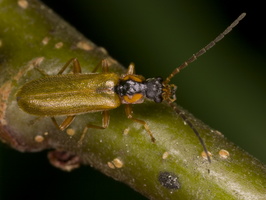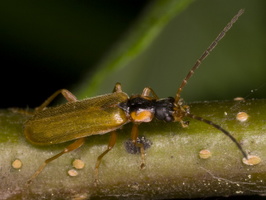 home / Insecta · vabzdžiai / Coleoptera · vabalai / Cantharidae · minkštavabaliai / Rhagonycha testacea · minkštavabalis
home / Insecta · vabzdžiai / Coleoptera · vabalai / Cantharidae · minkštavabaliai / Rhagonycha testacea · minkštavabalis

Rhagonycha testacea · minkštavabalis
- pensassylkikuoriainen
- zmięk żółtonogi
- ukbeetles.co.uk/rhagonycha-testacea
- naturespot.org/species/rhagonycha-testacea
- gbif.org/species/4429793
4-6 mm, light golden elytra, well-defined darker mark on the yellow-orange pronotum, legs are entirely yellow.
This is a mostly central and northern European species; it extends south into southern France, northern Italy and Ukraine but is generally absent from the Balkans and the Mediterranean islands, to the east it extends through Russia to the far east of Siberia and to the north it reaches the UK and into northern parts of Fennoscandia, it is locally common in lowlands throughout the region and extends into foothills and lower valleys in mountain regions. Adults are diurnal and active over a short season from late April or May until July, they typically occur in damp wooded areas and marshland but they fly well and visit a range of flowers and from late spring are often common along hedgerows and in parks and gardens. The first adults are often seen on spring blossom, especially hawthorn where they may be very common and where mating pairs are often seen, but soon they appear on umbels and thistles etc., they are predatory and hunt other insects on foliage and flowers but may also be seem consuming nectar and pollen. Larvae develop through the summer and into the autumn, they are cold-tolerant and often continue feeding during milder winter spells and they pupate in the ground during the spring. Adults are easily recorded from blossom in the spring, they usually occur in numbers and often beside superficially-similar members of the family and so will need to be examined carefully.
5-6 mm. A small and delicate species, head entirely black, pronotum yellow with a broad median black stripe that extends to the apical and basal margins, scutellum black, elytra and legs yellow, the tarsi sometimes darkened apically, antennae yellow with at least some apical segments darkened. Head smoothly convex with large convex eyes and converging temples, apical maxillary palpomere securiform and usually extensively darkened, antennae long and filiform. Pronotum quadrate with near-parallel lateral margins, rounded anterior angles and obtuse posterior angles, surface flat but depressed laterally, the dark central stripe characteristically expanded about the middle. Elytra slightly dilated from rounded shoulders to separately-curved apical margins, pale brown to yellow, randomly punctured and finely uneven throughout and with various weak longitudinal ridges but without striae, entire surface with fine pale and recumbent pubescence. Tarsi with only the fourth segment deeply bilobed, middle and hind claws bifid.
Rhagonycha nigriventris also has a dark pronotal marking but here it does not reach the front and hind margins and the femoral bases are dark. Cantharis decipiens, also with a dark pronotal marking, has darkened hind femora but is easily separated by the unequal claws; the anterior of each pair is toothed while the posterior is simple. Other species with a bicoloured pronotum have either dark (Cantharis spp.) or are smaller and have bicoloured elytra (Malthodes and Malthinus).

